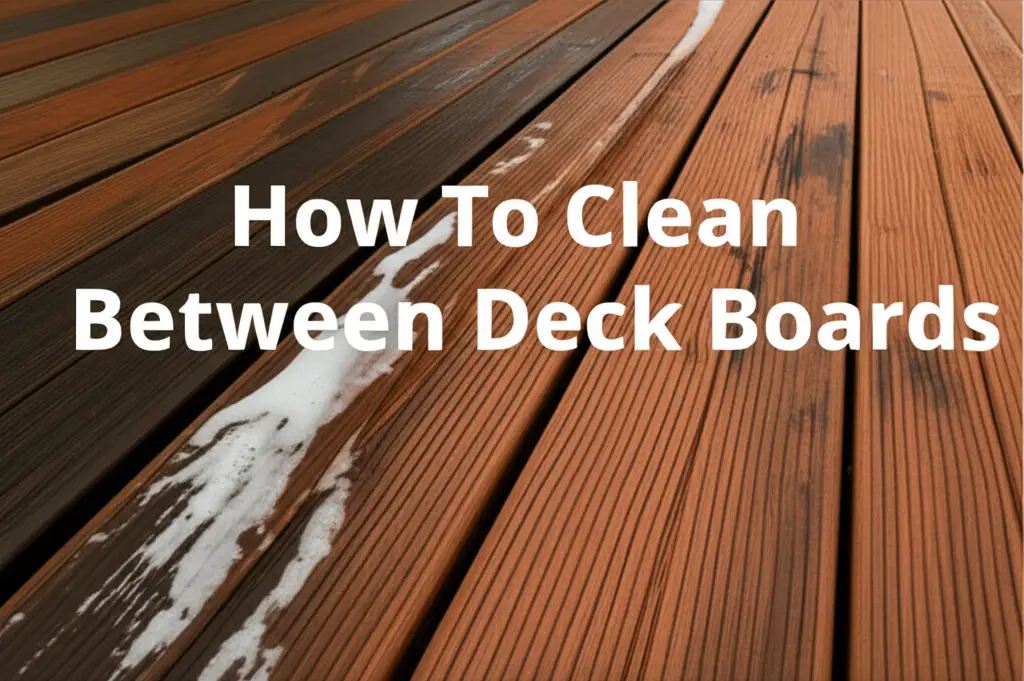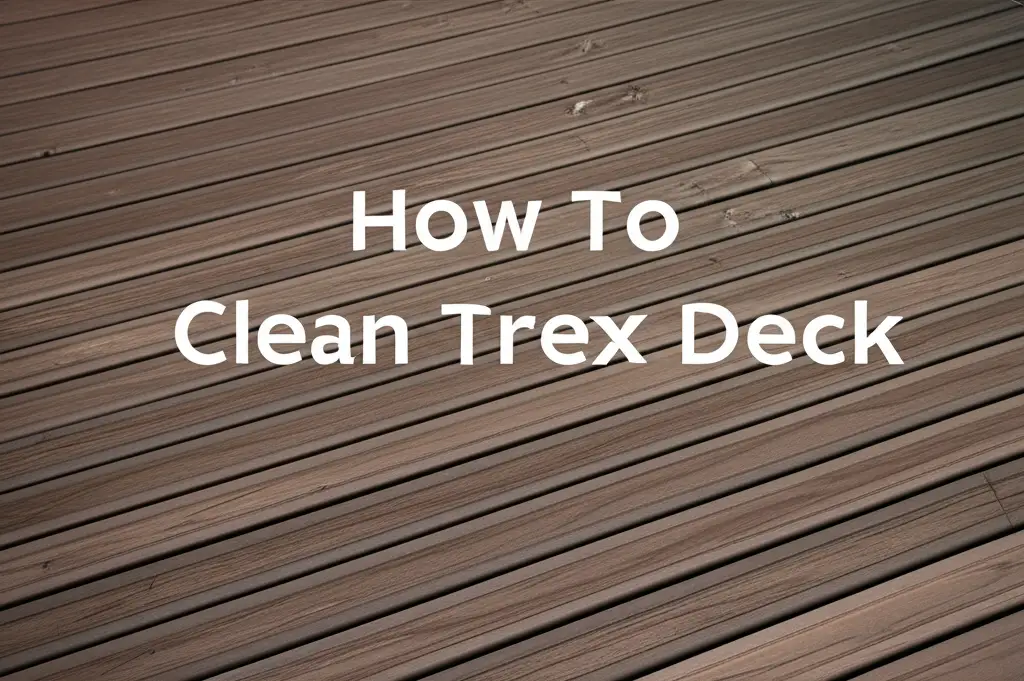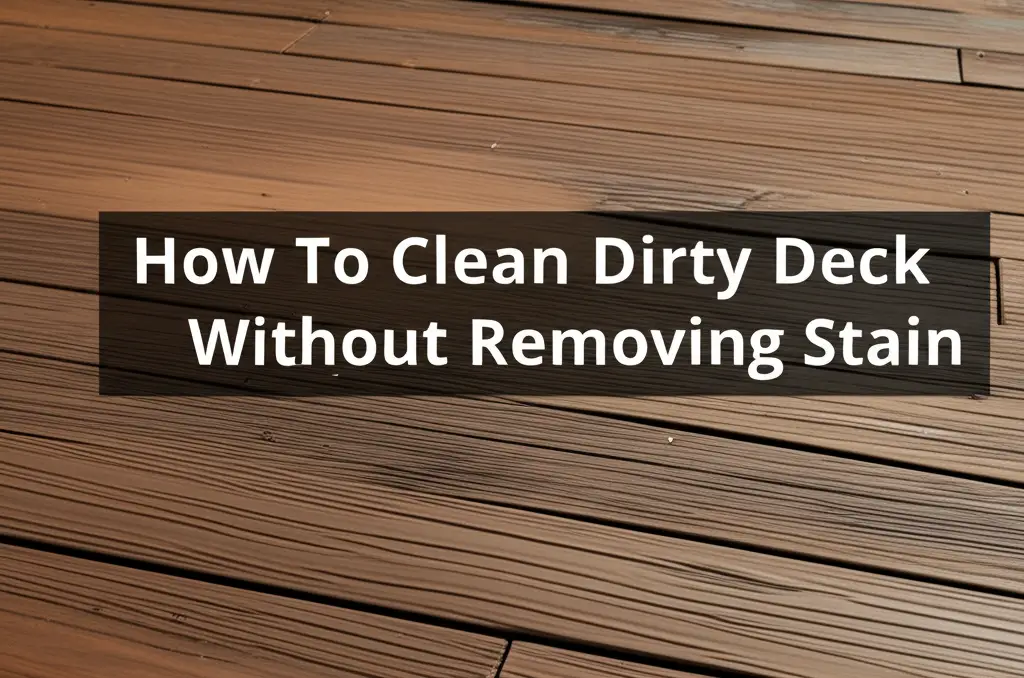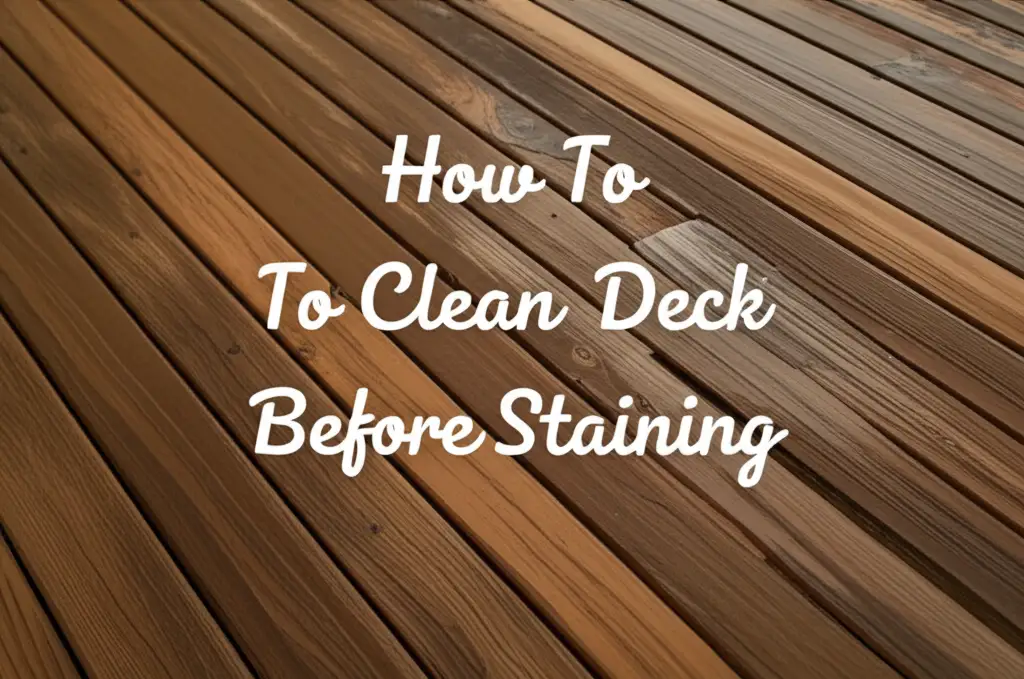· Deck Maintenance · 16 min read
How To Clean Pollen Off Deck
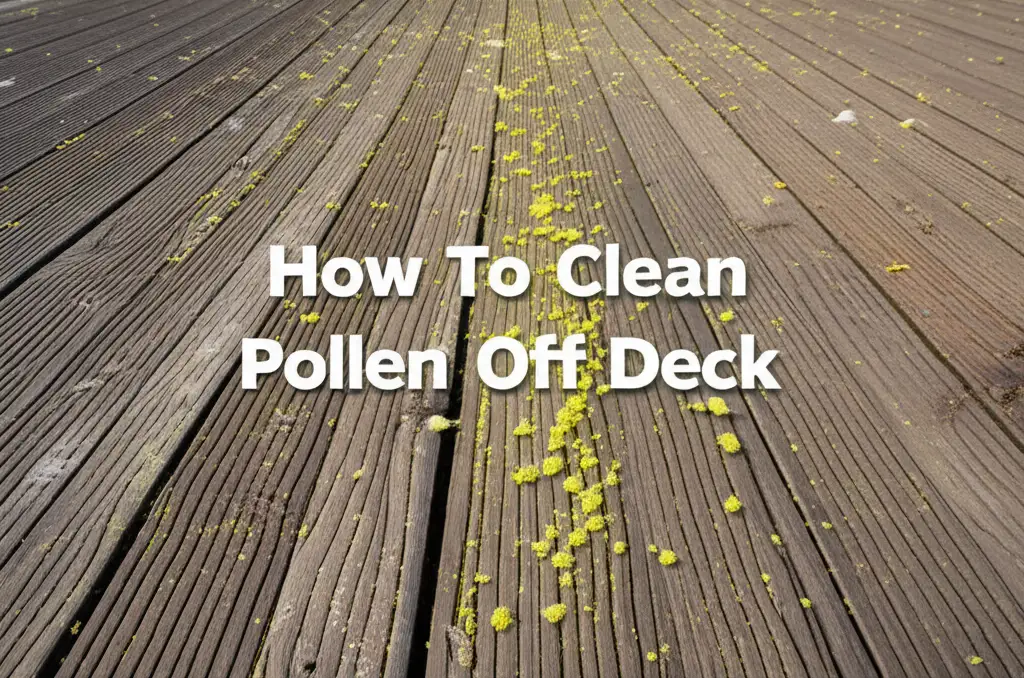
Clear Your Deck: How To Clean Pollen Off Deck Effectively
Spring is here, and with it comes bright sunshine and warm weather. It also brings the yellow powdery dust of pollen. You love spending time on your deck. Then, one day, you step outside. Your beautiful outdoor space is covered in a yellow film. This film is pollen. It sticks to surfaces. It makes your deck look dirty. Pollen can also make outdoor time less enjoyable, especially for allergy sufferers.
Cleaning pollen off your deck seems like a big job. You may wonder where to start. Many people think it needs harsh chemicals or a lot of effort. This is not true. You can clean pollen off your deck using simple tools and techniques. This guide shows you how to clean pollen off deck surfaces safely and efficiently. We will cover gentle methods and powerful solutions. You will learn about preparing your deck, choosing the right tools, and even preventing future buildup. Get ready to reclaim your clean, inviting deck.
Takeaway
- Start by dry sweeping or blowing pollen away.
- Use a garden hose for initial rinse.
- Apply gentle cleaning solutions like dish soap or vinegar for stuck-on pollen.
- Consider a pressure washer with low PSI for tough areas, following safety rules.
- Adjust cleaning methods based on deck material: wood, composite, or painted.
- Prevent future pollen by regular maintenance and smart landscaping.
Cleaning pollen off your deck involves simple steps. First, remove loose pollen with a broom or leaf blower. Then, use a garden hose with a spray nozzle. For stubborn areas, apply a gentle cleaner. You can use dish soap or a diluted vinegar solution. Rinse the deck thoroughly. This leaves your deck clean and ready for enjoyment.
Understanding Pollen and Its Impact on Decks
Pollen is a fine, powdery substance. Plants release it, especially trees and grasses. This happens mainly in spring and early summer. The wind carries pollen everywhere. It lands on cars, outdoor furniture, and, of course, decks. Pollen looks like yellow dust. It can build up quickly. A heavy pollen layer makes your deck look dull. It can even feel gritty underfoot.
Pollen is a natural part of the environment. While not directly damaging to deck materials in the short term, it creates an unsightly mess. It can also hold moisture. This moisture could encourage mildew growth over time. Removing pollen helps keep your deck clean. It also protects its surface from potential long-term issues. Regular cleaning is important for deck health and appearance.
Pollen can affect people with allergies. If your deck is covered in pollen, spending time outdoors can trigger sneezes and itchy eyes. A clean deck means a more comfortable outdoor space for everyone. It also prevents tracking pollen inside your home. Maintaining a clean deck is good for both your property and your family’s comfort.
Essential Tools and Supplies for Pollen Removal
Before you begin cleaning pollen off your deck, gather your tools. Having everything ready makes the job easier and faster. You likely have many of these items already. Knowing what you need helps you prepare for the task ahead.
Your basic kit for deck pollen removal includes a broom or leaf blower. You will also need a garden hose with a spray nozzle. A bucket and a soft-bristle brush are helpful too. For cleaning solutions, simple dish soap often works well. White vinegar is another good option for natural cleaning. For tougher pollen, you might consider an oxygen bleach solution.
If you plan to use a pressure washer, ensure you have the right nozzle. A 25-degree or 40-degree tip is best for decks. Always wear safety glasses and closed-toe shoes when pressure washing. Having the right tools ensures a safe and effective cleaning process. Prepare your supplies before you start.
Preparing Your Deck for Pollen Cleaning
Proper preparation makes cleaning pollen off your deck much simpler. Do not rush this step. It sets the stage for a thorough and efficient clean. A well-prepared deck ensures cleaning solutions and water can work best.
First, clear everything off your deck. Move all furniture, planters, and decorations. This gives you a clear workspace. It also prevents anything from getting wet or damaged during cleaning. Store items in a garage or on a patio for a short time.
Next, sweep your deck thoroughly. Use a stiff-bristle broom to remove loose pollen, leaves, and dirt. A leaf blower also works very well for this initial step. Blowing off dry debris prevents it from turning into mud once you add water. This dry removal is key to preventing streaks. You can also use a vacuum designed for outdoor use. This initial dry sweep removes a lot of pollen before you even introduce water.
- Remove Furniture: Clear all items from the deck surface.
- Sweep or Blow: Use a broom or leaf blower to remove loose pollen and debris. This helps you clean your deck without removing stain. how to clean dirty deck without removing stain
- Protect Nearby Plants: If using cleaning solutions, cover delicate plants with plastic sheeting.
After sweeping, quickly inspect your deck for any other issues. Look for stubborn stains or areas needing special attention. This preparation step saves you time in the long run. It also helps you achieve a truly clean deck surface.
Gentle Methods to Remove Pollen
You do not always need harsh chemicals or powerful machines to clean pollen off your deck. Gentle methods often work very well. These methods are safe for most deck materials. They are also good for the environment. You can use them for light pollen buildup or regular maintenance.
Sweeping and Blowing Away Pollen
The simplest way to start is by dry removal. Use a push broom with stiff bristles. Sweep all visible pollen and loose dirt off the deck. Work in small sections. Push the pollen off the deck edges. This step is surprising in its effectiveness. It removes a large amount of pollen without any water.
A leaf blower is another excellent tool for dry pollen removal. It quickly blows pollen off the deck surface. Aim the blower towards the edges of your deck. Make sure to blow the pollen away from your home. This prevents it from landing on windows or siding. A leaf blower works especially well for reaching corners and crevices. This method is fast and efficient for light to moderate pollen. It is also good for a quick touch-up.
Using a Garden Hose with Spray Nozzle
After dry removal, use a garden hose. A standard garden hose with a spray nozzle provides enough pressure. Set the nozzle to a strong spray, but not a jet stream. Spray the deck section by section. Start at one end and work your way to the other. Push the remaining pollen off the deck.
Rinse the deck thoroughly. Make sure no soapy residue or pollen remains. Work with the slope of your deck. This helps the water and pollen drain away. This method is effective for fresh pollen. It is also great for rinsing after applying a cleaning solution. A hose provides a gentle, yet effective, wash. It also helps remove pollen from a screened porch, similar to how it works on an open deck. how to clean pollen off screened porch
These gentle methods are perfect for regular upkeep. They help you keep your deck looking clean throughout pollen season. They are also safe for various deck materials.
Using a Pressure Washer for Stubborn Pollen
When pollen buildup is thick or stuck on, a pressure washer can be your best friend. A pressure washer uses high-pressure water to remove dirt. It works fast and is very effective. However, using it correctly is important. Incorrect use can damage your deck surface.
Pressure Washing Techniques for Decks
Choose the right nozzle for your pressure washer. A 25-degree (green tip) or 40-degree (white tip) nozzle is ideal for decks. These tips create a wide spray pattern. This reduces the risk of damage. Always start with a low pressure setting. Test a small, hidden area of your deck first. This lets you check how the deck material reacts.
Hold the nozzle about 12-18 inches from the deck surface. Keep the wand moving in smooth, overlapping strokes. Work with the grain of the wood if you have a wood deck. Do not linger in one spot. This can cause streaks or gouge the surface. Overlapping strokes ensure an even clean. This method works well for pollen and other deck grime. It can also help when you clean a deck before staining. how to clean deck before staining
Safety First When Pressure Washing
Pressure washers are powerful tools. They need proper handling. Always wear safety glasses to protect your eyes from debris. Wear closed-toe shoes to protect your feet. Never point the nozzle at people, pets, or electrical outlets. Maintain a firm grip on the wand. The kickback can be strong when you start the machine.
Work slowly and steadily. Do not try to clean too fast. Take breaks if your arms get tired. Store your pressure washer safely after use. Follow all manufacturer instructions for your specific model. Proper safety ensures a clean deck without accidents. Remember, safety always comes first.
DIY Cleaning Solutions for Deck Pollen
Sometimes, water alone is not enough to get rid of stubborn pollen. You can make effective cleaning solutions using common household items. These DIY solutions are safe for most decks. They are also more eco-friendly than harsh chemicals. Always test any solution on a small, hidden area first. This helps ensure it does not harm your deck material.
Vinegar-Based Pollen Cleaner
White vinegar is a powerful natural cleaner. It helps break down pollen and grime. Mix equal parts white vinegar and water in a bucket. For example, use one gallon of vinegar and one gallon of water. You can also add a few drops of dish soap for extra cleaning power.
Apply the solution to your deck using a soft-bristle brush or a mop. Let it sit for 10-15 minutes. Do not let it dry on the surface. Scrub the deck gently. Then, rinse thoroughly with a garden hose. Vinegar is safe for most deck materials. It is also good for cleaning other surfaces like showers. how to clean shower with vinegar This solution works well for pollen and light mold. how to clean mold with vinegar
Dish Soap Solution for Mild Pollen
For light pollen or regular cleaning, a simple dish soap solution works wonders. Fill a bucket with warm water. Add a few squirts of mild dish soap. Do not use too much, as it can create excessive suds. Mix until the soap dissolves.
Pour the soapy water over a section of your deck. Use a soft-bristle brush or a deck brush. Scrub the area gently. The soap helps lift the pollen from the surface. Rinse the section immediately and completely with a garden hose. Make sure no soap residue remains. Repeat this process until your entire deck is clean. This method is very gentle. It is safe for almost all deck types.
Oxygen Bleach for Tougher Stains
For very stubborn pollen or areas with mildew, oxygen bleach is a good choice. It is gentler than chlorine bleach. It will not discolor most deck materials. Follow the product instructions for mixing. Usually, you mix oxygen bleach powder with water.
Apply the solution to the deck surface. Let it soak for the recommended time, usually 15-30 minutes. Use a soft brush to scrub any tough spots. Rinse the deck thoroughly with plenty of water. Make sure to remove all traces of the solution. Oxygen bleach is effective for deep cleaning. It helps restore your deck’s original look. Always wear gloves and eye protection when using any bleach product.
Special Considerations for Different Deck Materials
Not all decks are the same. The best way to clean pollen off your deck depends on its material. Wood, composite, and painted decks each have unique characteristics. Using the wrong method can cause damage. Always adjust your cleaning approach to match your deck type. This ensures safety and effectiveness.
Cleaning Pollen from Wood Decks
Wood decks, whether cedar, redwood, or pressure-treated, are beautiful. They also need careful cleaning. Wood is porous. It can absorb moisture and cleaners. When cleaning pollen from wood, always work with the grain. This prevents scratching and helps lift dirt.
Start with sweeping or blowing. Then, use a garden hose. For a deeper clean, use a dish soap solution or a specialized wood deck cleaner. Apply the cleaner, scrub gently with a soft brush, and rinse quickly. If using a pressure washer, keep the PSI very low (under 1200 PSI). Use a wide-angle nozzle (40-degree). Hold the wand at least a foot away from the surface. High pressure can splinter wood or strip finishes. You should also consider how to clean stains on wood. how to clean stains on wood Always rinse wood decks completely to avoid water spots or residue.
Cleaning Pollen from Composite Decks
Composite decks are made from a mix of wood fibers and plastic. They are very durable and low maintenance. This makes them easier to clean than wood. They are less porous and resist staining better. You can still get pollen on them.
For composite decks, a broom or leaf blower works great for loose pollen. A garden hose with a spray nozzle is usually enough for daily pollen. If pollen is stubborn, use a mild dish soap solution. Scrub with a soft-bristle brush. Rinse thoroughly. You can use a pressure washer on composite decks. Set the PSI to a moderate level (around 1500-2000 PSI). Use a fan tip. Test a small area first to ensure it does not scratch the surface. Composite decks generally handle cleaning well. They rarely require harsh chemicals.
Cleaning Pollen from Painted or Stained Decks
Painted or stained decks have an extra layer of protection. This layer can also be sensitive to harsh cleaning. The goal is to clean without stripping the finish. Start with the gentlest methods.
Sweep or blow off the loose pollen. Then, use a garden hose for rinsing. For stuck-on pollen, a mild dish soap solution is best. Mix a small amount of dish soap with warm water. Use a soft sponge or cloth to wipe the deck. Avoid abrasive brushes. Scrub very gently. Rinse quickly and thoroughly.
Do not use a pressure washer on painted or stained decks. High pressure can chip, peel, or damage the finish. This will require more work later. Avoid harsh cleaners, as they can also strip the paint or stain. Stick to mild solutions and gentle scrubbing for these surfaces. This keeps your deck looking fresh for longer.
Preventing Future Pollen Buildup on Your Deck
Once you clean pollen off your deck, you want to keep it that way. While you cannot stop pollen from falling, you can reduce its buildup. Proactive steps save you time and effort later. These strategies help maintain a cleaner deck throughout pollen season.
Regular Maintenance During Pollen Season
The best defense against heavy pollen is regular light cleaning. During peak pollen season, aim to sweep or blow your deck every few days. This removes pollen before it has a chance to stick. A leaf blower is excellent for this quick task. It only takes a few minutes.
A quick rinse with a garden hose can also help. Do this once or twice a week. It washes away accumulating pollen. This prevents it from forming a thick, stubborn layer. Regular, light maintenance is far easier than a deep clean later. It keeps your deck usable and enjoyable.
Using Protective Measures
Consider using an outdoor rug or mat in high-traffic areas. This can collect some pollen. Shake it out regularly. You can also cover your outdoor furniture with protective covers when not in use. This keeps them cleaner and reduces the pollen landing on the deck surface.
Some people apply a deck sealant or stain. These products create a smoother surface. This can make it harder for pollen to stick. It also makes subsequent cleaning easier. Make sure the product is suitable for your deck material. Always follow the manufacturer’s application instructions. A good sealant can offer a protective barrier.
Strategic Landscaping
Look at the trees and plants around your deck. Are there many pollen-producing trees nearby? If you are planning new landscaping, choose low-pollen plants. Avoid planting high-pollen trees like oaks, maples, or pines right next to your deck.
If you have existing trees, you can’t easily remove them. However, keeping them well-pruned can help manage some pollen. While this won’t eliminate pollen, it can reduce the amount directly falling onto your deck. Strategic planting choices can lessen your deck cleaning burden.
FAQ Section
Can I use bleach to clean pollen off my deck?
Avoid using chlorine bleach on your deck. Chlorine bleach can damage wood fibers. It can also strip stains and finishes. It is harsh on most deck materials. Use oxygen bleach instead. Oxygen bleach is much gentler. It works well to clean pollen and mold without damage.
How often should I clean pollen off my deck?
During peak pollen season, clean your deck every few days. A quick sweep or blow-off helps immensely. A full wash may be needed every 1-2 weeks. This depends on how much pollen falls in your area. Regular light cleaning is easier than deep cleaning a thick layer.
Is pollen harmful to my deck material?
Pollen itself is not directly harmful to deck material. It does not cause immediate damage. However, a thick layer of pollen can trap moisture. This might encourage mold or mildew growth over time. Regular cleaning prevents these secondary issues. It also keeps your deck looking good.
What is the best time of day to clean pollen?
The best time to clean pollen is usually in the morning. Pollen counts are often lower early in the day. The dew can also help loosen some of the pollen. Avoid cleaning in the late afternoon or evening. Winds can pick up, and more pollen might be falling.
Does a leaf blower work well for deck pollen?
Yes, a leaf blower works very well for removing loose pollen. It is quick and efficient. It can clear large areas fast. Use it for initial dry removal. It helps you get rid of most of the pollen before you use water. This prevents creating muddy streaks.
Will rain wash away pollen from my deck?
Rain can wash away some pollen. However, heavy rain often makes pollen stickier. It creates a muddy film that is harder to remove. Light rain might rinse it, but a good manual cleaning ensures a truly clean deck. Do not rely solely on rain to clean your deck.
Conclusion
Pollen season brings the beauty of spring but also a yellow mess on your deck. You now have the tools and knowledge to tackle this common problem. Cleaning pollen off your deck is a manageable task. It does not require harsh chemicals or difficult methods. By following simple steps, you can restore your deck’s appearance.
Remember to start with dry removal using a broom or leaf blower. Then, use a garden hose for rinsing. For stubborn areas, gentle DIY solutions like dish soap or vinegar work wonders. If you use a pressure washer, always apply caution. Always choose the right method for your deck material. Regular maintenance is key to preventing heavy buildup. With these tips, your deck will stay clean and inviting. Get ready to enjoy your beautiful outdoor space all season long. Take action today to reclaim your clean deck!
- deck cleaning
- pollen removal
- outdoor living
- spring cleaning
- deck maintenance

